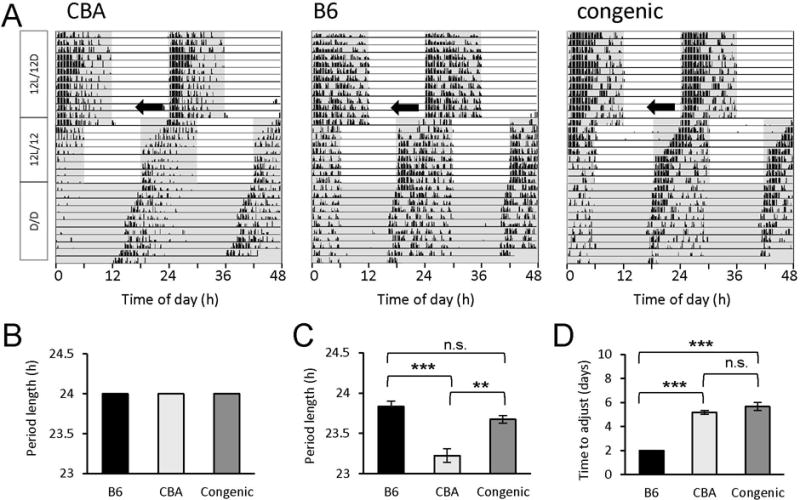Figure 3.

Locomotor activity rhythms of CBA, B6 and congenic mice under a 12-h light/12-h dark cycle (12L/12D) or in constant dark conditions (D/D). A: Representative double-plotted profiles of wheel-running activity of a CBA mouse (left panel), a B6 mouse (middle panel), and a double-homozygous congenic mouse (right panel), obtained (from top to bottom) under a 12L/12D cycle, including after a 6-h phase shift (jetlag paradigm, black arrows), and D/D. B and C: Average period lengths of the wheel activity rhythm under 12L/12D (B) and D/D conditions (C). Mice from all genotypes had a period length of exactly 24.0 h under 12L/12D (B) and were able to run freely under D/D conditions with a period slightly shorter than 24 h (C). A two-way ANOVA of the data illustrated in (B) and (C) revealed significant differences between the lighting regimens (F(1,18) = 129, P = 1.23e-9) as well as between genotypes (F(2,18) = 25.6, P = 5.42e-6) and interaction lighting cycles x genotypes (F(2,18) = 25.6, P = 5.42e-6). Tukey’s post hoc test revealed a significant difference between CBA and B6 mice (***, P = 2.92e-4) and CBA and congenic mice (**, P = 0.00679) but not between B6 and congenic animals (not significant [n.s.], P = 0.256). D: Time to adjust the onset of activity after a 6-h phase advance. A one-way ANOVA revealed significant differences between genotypes in the speed to which mice adjusted to the new phase (F(2,9) = 76.5, P = 2.25e-6). Specifically, B6 mice adjusted much faster (within 2 days) to the new phase compared to CBA (***, P = 4.37e-6) or congenic mice (***, P = 4.27e-6), which did so in ~ 5 to 6 days. No difference was found between CBA and congenic mice (n.s., P = 0.246). Data were collected from 3 B6, 6 CBA, and 4 congenic mice. Error bars represent SEM. Shaded areas in A indicate periods of darkness.
